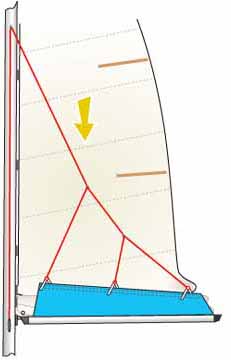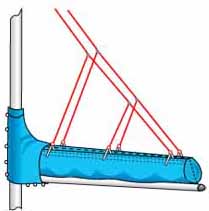Lazy Jacks: How They Simplify Mainsail Handling
In a Nutshell...
If you've got a slab-reefing mainsail, a lazy jack system is one of those pieces of kit you'll wonder how you ever lived without. It's a simple arrangement of lines that form a cradle on either side of the mainsail boom, catching the sail as it comes down. Believe me, this little setup makes handling and stowing your main a whole lot easier. You can forget about the fuss of wrestling with a big, unruly sail—lazy jacks make the job a breeze, and they're a reliable alternative to those more complicated in-mast or in-boom furling systems.
Table of Contents
- What are Lazy Jacks & Why Do You Need Them?
- How to Install a Lazy Jack System
- Can You Combine Lazy Jacks With a Mainsail Cover?
- What are the Different Types of Lazy Jack Systems?
- What's the Catch When Hoisting the Mainsail?
- Lazy Jacks Compared to Alternatives
- Materials & Maintenance
- Summing Up
- Frequently Asked Questions
What are Lazy Jacks & Why Do You Need Them?
 Lazyjacks retain the sail on the boom when a slab is pulled in.
Lazyjacks retain the sail on the boom when a slab is pulled in.For any sailboat owner with a slab-reefing mainsail, getting to grips with a lazy jack system is a game-changer. While they're not absolutely essential, they will dramatically simplify the process of putting a reef in or stowing the sail at the end of a day. Without them, you'd have to find some other way to control all that loose sail fabric once you've reefed.
Back in the day, sailors would use reef cringles and pennants. The cringles are those rows of reinforced eyelets on the sail, and the pennants are short lengths of line you'd use to tie the sail down to the boom. While that method can keep things neat, it can also create point loads in unreinforced sections of the sail, and a lot of mainsails have been damaged that way. Not to mention the headache if you forget to untie them before hoisting your sail again.
How to Install a Lazy Jack System
Installing a lazy jack system is pretty straightforward. You don't need any high-tech gear; just a few basic components and some know-how.
- Blocks: You'll need a couple of small blocks, one for each side of the mast, typically rigged about halfway to three-quarters of the way up from the gooseneck. That's where the upper lines of the system attach.
- Cleats: Install a small cleat at a convenient spot near the gooseneck on the mast for securing the lines when they're not in use.
- Lines: You'll need several lengths of 10mm (3/8") line to create the "cat's cradle" that holds the sail.
- Padeyes: These are small fittings that get screwed onto the boom, serving as the attachment points for the lower lines.
- Swivel Blocks or Hard Eyes: You can use swivel blocks where the lines intersect for less friction, especially on bigger boats. But for smaller mainsails, hard eyes with plastic thimbles will do the job just fine.
The whole setup is adjustable, so you can position the padeyes on the boom to suit the specific needs of your sail and boom length.
Can You Combine Lazy Jacks With a Mainsail Cover?
Combining lazy jacks with a custom canvas mainsail cover—what's often called a 'Stack Pack'—is a really nifty idea. This setup offers some serious benefits that make life a lot easier out on the water.
- Effortless Stowing: As you drop the sail, the lazy jacks guide it right into the integral cover.
- Quick & Easy: Once the sail is down, you just zip the cover up. No more struggling to drag a heavy, conventional cover out of a locker and wrestling it over the mainsail. It cuts your time in half, giving you more time to kick back.
- Protection: It keeps your mainsail safely protected from the sun's UV rays and the elements.
On my own yacht, Alacazam, I've got a similar system with all the controls at the mast, and it works a treat. You could also easily lead all the lines back to the cockpit if that's what you prefer—but I've already got enough string down there!
 A Lazy Jack 'Stack Pack' system
A Lazy Jack 'Stack Pack' systemWhat are the Different Types of Lazy Jack Systems?
While the core idea is always the same, you'll find these systems in two main setups, depending on the boat's size and boom length.
| System Type | Description | Best For |
|---|---|---|
| Two-Leg System | A simple "V" shape formed by two lines from the mast to the boom. | Smaller boats or those with shorter booms. |
| Three-Leg System | An extra set of lines closer to the mast to create a more enclosed cradle. | Longer booms or larger mainsails for better sail containment. |
For a longer boom, you'll want to go with a three-leg system. It gives you a more effective and reliable cradle, so the sail can't spill out over the side as it comes down.
What's the Catch When Hoisting the Mainsail?
Here's the one small drawback: while lazy jacks are a whiz at catching the mainsail on the way down, they're just as good at catching the ends of the battens on the way up. But don't worry, there are a few simple ways to handle it.
- The Classic Method: The easiest fix is to simply slacken the lazy jack lines before you hoist, pull them forward, and tie them off on the mast. If your slab reefing system has them, the reefing hooks are a perfect place for this. Once the sail's up and you've trimmed it, you can re-tension the lazy jacks.
- The "Two-Part" System: For a really slick setup, you can rig a two-part lazy jack system. This lets you pull the lines forward and down to the gooseneck, getting them completely out of the way of the battens. It's especially handy for full-batten mainsails.
- The Helmsman's Role: This might sound obvious, but it's crucial. Make sure your helmsman points the boat dead into the wind—also called being "in irons." This creates a perfect wind shadow behind the mast, allowing the sail to rise smoothly and vertically without getting pushed into the lines.
Lazy Jacks Compared to Alternatives
For me, lazy jacks are a no-brainer, but it's worth knowing what other options are out there for handling your mainsail.
| System | Pros | Cons |
|---|---|---|
| Lazy Jacks | Inexpensive, simple, reliable, can be self-installed. | Can snag battens; may chafe sail if not properly tensioned. |
| In-Mast Furling | Convenient, easy to operate from the cockpit. | Expensive, mechanically complex, poor sail shape, can jam. |
| In-Boom Furling | Very expensive, complex, requires a rigid vang. | Keeps weight low, good sail shape, operated from the cockpit. |
| Dutchman System | Works with full-batten sails, very effective flaking. | Requires sail modification, more expensive than lazy jacks, can be difficult to set up correctly. |
I'll tell you what, for me, the simplicity and reliability of a well-rigged lazy jack system, coupled with the great sail shape you get from a conventional mainsail, makes it the clear winner for ocean cruising.
Materials & Maintenance
The secret to a long-lasting lazy jack system lies in the materials you choose and how you look after them.
- Line Selection: Use a marine-grade, pre-stretched polyester line, like braid-on-braid, for the lazy jacks themselves. Avoid anything too stretchy like nylon, which just won't cut it. A line diameter of around 8-10mm (3/8") is a good all-around choice.
- Fittings: For a low-friction system, it's worth using small blocks where the lines join and at the mast. But if you're on a budget, plastic thimbles are a cost-effective alternative for smaller boats.
- Ongoing Maintenance: Lazy jacks are pretty low maintenance, but you should still give them a quick once-over every now and then. Look out for any signs of chafe where the lines rub against the sail or the boom, and make sure all the blocks and fittings are still secure and running smoothly.
Summing Up
Getting to grips with sail handling can be a challenge, but a system like lazy jacks is a great way to start mastering the controls and ensuring safety at sea. To learn more about this and other essential sail handling techniques, read our ultimate guide to Reefing a Sail: The Ultimate Guide to Control & Safety at Sea.
You just can't beat lazy jacks for their mix of simplicity, reliability, and value. They take the fuss out of managing a big, unruly mainsail, keep it neatly contained on the boom, and can be easily combined with a sail cover for a truly elegant solution. When you weigh them up against those more complex and costly furling systems, lazy jacks are a straightforward, robust choice that simplifies your sailing life without breaking the bank.
This article was written by Dick McClary, RYA Yachtmaster and author of the RYA publications 'Offshore Sailing' and 'Fishing Afloat', member of The Yachting Journalists Association (YJA), and erstwhile member of the Ocean Cruising Club (OCC).
Frequently Asked Questions
What are the main benefits of a lazy jack system?
What are the main benefits of a lazy jack system?
Lazy jacks simplify sail handling by catching and containing the mainsail as it is lowered, making it much easier to reef and to stow the sail neatly on the boom.
Can I install lazy jacks myself?
Can I install lazy jacks myself?
Yes, installing a lazy jack system is a straightforward project that most competent sailors can do themselves with basic tools and some cordage.
Are lazy jacks compatible with all mainsails?
Are lazy jacks compatible with all mainsails?
Lazy jacks are most commonly used with slab-reefing mainsails. They are not compatible with in-mast furling systems, nor are they necessary.
Do lazy jacks affect the performance of the sail?
Do lazy jacks affect the performance of the sail?
When properly installed and tensioned, lazy jacks have no significant impact on sail performance. However, they should be slackened when hoisting the sail to prevent the battens from snagging.
How do I maintain my lazy jacks?
How do I maintain my lazy jacks?
Maintenance is minimal. Regularly check the lines for chafe, ensure the blocks are running freely, and inspect the attachment points on the mast and boom.
Recent Articles
-
Hans Christian 43: Classic Bluewater Cruiser & Liveaboard Sailboat
Dec 10, 25 04:37 AM
Explore the Hans Christian 43: a legendary heavy-displacement, long-keel sailboat. Read our in-depth review of its specs, design ratios, and suitability for offshore cruising and living aboard. -
Planning Your Sailboat Liveaboard Lifestyle: An Ocean Sailor's Guide
Dec 06, 25 05:18 AM
Seasoned sailors share their methodical risk analysis for planning a secure Sailboat Liveaboard Lifestyle, covering financial, property, and relationship risks. -
Marine Cabin Heaters: The Expert’s Guide to Comfort & Safety at Sea
Dec 05, 25 06:52 AM
Choose the best Marine Cabin Heaters for your vessel. Expert advice on diesel, paraffin, and hot water systems for year-round cruising comfort.












